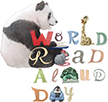 The bibliophiles among us are convinced that every new day offers tantalizing possibilities for opening a new book and finding adventure or learning something new. Reading experts have long known that shared reading through read alouds is an excellent way to foster the love for books and literacy in others. World Read Aloud Day, celebrated March 5, is intended as a reminder of the importance of reading and sharing stories. Find out more about LitWorld, which spearheads this campaign supporting literacy, at http://litworld.org. In honor of that campaign and as an excuse to read some terrific books, members of the International Reading Association’s Children’s Literature and Reading Special Interest Group (CL/R SIG) share some of their recent favorite read alouds this week. Something tells us you won’t be able to stop with reading just one book.
The bibliophiles among us are convinced that every new day offers tantalizing possibilities for opening a new book and finding adventure or learning something new. Reading experts have long known that shared reading through read alouds is an excellent way to foster the love for books and literacy in others. World Read Aloud Day, celebrated March 5, is intended as a reminder of the importance of reading and sharing stories. Find out more about LitWorld, which spearheads this campaign supporting literacy, at http://litworld.org. In honor of that campaign and as an excuse to read some terrific books, members of the International Reading Association’s Children’s Literature and Reading Special Interest Group (CL/R SIG) share some of their recent favorite read alouds this week. Something tells us you won’t be able to stop with reading just one book.
Grades K-3
Bardoe, Cheryl (2014). Behold the beautiful dung beetle. Illus. by Alan Marks. Watertown, MA: Charlesbridge.
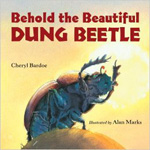 It might seem unlikely that anything could make the humble dung beetle particularly interesting, but this book has done just that. Filled with watercolor and pencil illustrations, the book describes three different types of dung beetles (dwellers, tunnelers, and rollers) and the work they do in removing fecal materials from where they have been dropped. It's fascinating to learn what those beetles do with all the dung they collect and to know that dung beetles make efficient use of the materials that others might disdain. This one is sure to be a hit in the elementary grades because of its subject matter and the sparkling writing that matter-of-factly describes the daily labors of dung beetles and how quickly they can remove dung. The back matter includes interesting facts such as the number of dung beetle species and the observation that they don't eat their own dung.
It might seem unlikely that anything could make the humble dung beetle particularly interesting, but this book has done just that. Filled with watercolor and pencil illustrations, the book describes three different types of dung beetles (dwellers, tunnelers, and rollers) and the work they do in removing fecal materials from where they have been dropped. It's fascinating to learn what those beetles do with all the dung they collect and to know that dung beetles make efficient use of the materials that others might disdain. This one is sure to be a hit in the elementary grades because of its subject matter and the sparkling writing that matter-of-factly describes the daily labors of dung beetles and how quickly they can remove dung. The back matter includes interesting facts such as the number of dung beetle species and the observation that they don't eat their own dung.
- Barbara A. Ward, Washington State University Pullman
Fischer, Ellen. (2014). If an armadillo went to a restaurant. Illus. by Laura Wood. Minneapolis, MN: Scarletta/Scarletta Kids.
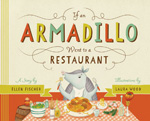 If animals could dine out in restaurants, what might they eat? This engaging picture book offers nine different animals the choice of human food before identifying what their preferred meal would be. Thus, a hedgehog rejects lasagna and a salad for some yummy beetles and three side orders of creatures most of us wouldn't try: bees, wasps, and snails. A butterfly turns its nose up at a bowl of nutritious oatmeal in favor of one filled with delectable nectar. The illustrations are lively and humorous, and there is even a small menu on the last page from which human readers can choose their favorite items for breakfast, lunch, or dinner. This short text would be a great introduction to a unit on the preferred nutrition of various animals.
If animals could dine out in restaurants, what might they eat? This engaging picture book offers nine different animals the choice of human food before identifying what their preferred meal would be. Thus, a hedgehog rejects lasagna and a salad for some yummy beetles and three side orders of creatures most of us wouldn't try: bees, wasps, and snails. A butterfly turns its nose up at a bowl of nutritious oatmeal in favor of one filled with delectable nectar. The illustrations are lively and humorous, and there is even a small menu on the last page from which human readers can choose their favorite items for breakfast, lunch, or dinner. This short text would be a great introduction to a unit on the preferred nutrition of various animals.
- Barbara A. Ward, Washington State University Pullman
Sierra, Judy. (2014). E-I-E-I-O: How old MacDonald got his farm (with a little help from a hen). Illus. by Matthew Myers. Somerville, MA: Candlewick Press.
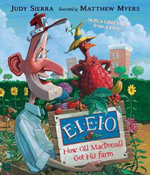 Exhausted from the never-ending care required in mowing his large backyard lawn, Old MacDonald decides to make some changes in that yard. The first step is purchasing a very smart hen that has ambitious plans for that once-green plot of grass. As the unhappy neighbors look on with disdain, Old MacDonald turns that green space into a productive garden, complete with goat, horse, and yummy vegetables. The rhyming text and acrylic and oil illustrations add considerably to the pleasures of reading this one. A particularly appealing illustration is the last one featuring a proud farmer and his red hen surveying the well-tended plots of fruits, flowers, and vegetables that surround them. If this is how Old MacDonald got his farm, several of us might want to consider following his lead.
Exhausted from the never-ending care required in mowing his large backyard lawn, Old MacDonald decides to make some changes in that yard. The first step is purchasing a very smart hen that has ambitious plans for that once-green plot of grass. As the unhappy neighbors look on with disdain, Old MacDonald turns that green space into a productive garden, complete with goat, horse, and yummy vegetables. The rhyming text and acrylic and oil illustrations add considerably to the pleasures of reading this one. A particularly appealing illustration is the last one featuring a proud farmer and his red hen surveying the well-tended plots of fruits, flowers, and vegetables that surround them. If this is how Old MacDonald got his farm, several of us might want to consider following his lead.
- Barbara A. Ward, Washington State University Pullman
Grades 4-6
Freedman, Russell. (2014). Angel Island: Gateway to Gold Mountain. New York, NY: Clarion Books.
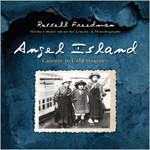 Anyone visiting San Francisco might want to visit Angel Island to see the exteriors and interiors of some of the buildings that once housed many of the immigrants trying to enter the United States from this western version of Ellis Island. This book would make an excellent companion for a tour of the facilities. In this thoroughly researched book filled with photographs, Freedman unearths the bigotry and fear that were at the roots of the Chinese Exclusion Act and the hardships endured by many of those who were detained at Angel Island for long periods of time. The inclusion of heartfelt poems written by those who felt imprisoned and disappointed as their dreams turned to ashes lends humanity to the plight of these immigrants. Their voices remind readers of some of this nation's mistakes and the palpable yearning for home many of the immigrants felt as they waited to be admitted to their new country.
Anyone visiting San Francisco might want to visit Angel Island to see the exteriors and interiors of some of the buildings that once housed many of the immigrants trying to enter the United States from this western version of Ellis Island. This book would make an excellent companion for a tour of the facilities. In this thoroughly researched book filled with photographs, Freedman unearths the bigotry and fear that were at the roots of the Chinese Exclusion Act and the hardships endured by many of those who were detained at Angel Island for long periods of time. The inclusion of heartfelt poems written by those who felt imprisoned and disappointed as their dreams turned to ashes lends humanity to the plight of these immigrants. Their voices remind readers of some of this nation's mistakes and the palpable yearning for home many of the immigrants felt as they waited to be admitted to their new country.
- Barbara A. Ward, Washington State University Pullman
Harley, Bill. (2014). Charlie Bumpers vs. the really nice gnome. Illus. by Adam Gustavson. Atlanta, GA: Peachtree Publishers.
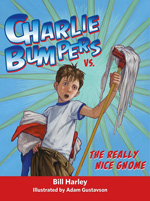 When his teacher, Mrs. Burke, plans to stage a play with her students, fourth grader Charlie Bumpers can't wait to take on the role of the Evil Sorcerer. After all, what fourth grade boy wouldn’t want to play a villain? To his dismay, he is cast as the Nice Gnome and immediately begins a campaign to get rid of his part. He can’t be seen on stage playing something nice. And if his plans to rid himself of his new role don't work, then he'll simply revise the script to give himself some funny lines. As in its predecessor, Charlie Bumpers vs. the Teacher of the Year (Peachtree, 2013), there are plenty of humorous moments as well as spot-on depictions of school and familial relationships in this book. Anyone who's ever been part of a classroom theatrical production knows that while the show must go on, it often heads off in unexpected directions. That’s exactly the case here.
When his teacher, Mrs. Burke, plans to stage a play with her students, fourth grader Charlie Bumpers can't wait to take on the role of the Evil Sorcerer. After all, what fourth grade boy wouldn’t want to play a villain? To his dismay, he is cast as the Nice Gnome and immediately begins a campaign to get rid of his part. He can’t be seen on stage playing something nice. And if his plans to rid himself of his new role don't work, then he'll simply revise the script to give himself some funny lines. As in its predecessor, Charlie Bumpers vs. the Teacher of the Year (Peachtree, 2013), there are plenty of humorous moments as well as spot-on depictions of school and familial relationships in this book. Anyone who's ever been part of a classroom theatrical production knows that while the show must go on, it often heads off in unexpected directions. That’s exactly the case here.
- Barbara A. Ward, Washington State University Pullman
Lamana, Julie T. (2014). Upside down in the middle of nowhere. San Francisco, CA: Chronicle Books.
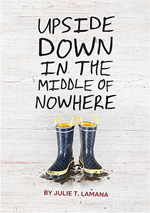 While a hurricane may be heading toward New Orleans in August 2005, all Armani Curtis can think about is her upcoming tenth birthday. Not telling her father about the evacuation plans of a neighbor ultimately leads to tragedy. While readers are certain to debate her actions, the author does a marvelous job of describing the close bonds among Armani's family members and the horrors of those first moments when water sweeps into the Ninth Ward where the Curtis family lives, sending them racing into the attic and onto the roof for safety. Readers will be caught up in the confusion outside the Superdome where the family eventually seeks shelter and then in another shelter, presumably in Baton Rouge. Because the narrative covers one week during the disaster, August 26 through September 2, it is easy to experience vicariously the uncertainty of Armani and her siblings as their whole world is turned topsy-turvy. The story ends hopefully, despite all the losses the main characters have suffered. Like their beloved city, the Curtis family will rise once again. Despite some of its flaws, the book provides readers with insight into one family's experience with a natural disaster and what it takes to keep going afterward.
While a hurricane may be heading toward New Orleans in August 2005, all Armani Curtis can think about is her upcoming tenth birthday. Not telling her father about the evacuation plans of a neighbor ultimately leads to tragedy. While readers are certain to debate her actions, the author does a marvelous job of describing the close bonds among Armani's family members and the horrors of those first moments when water sweeps into the Ninth Ward where the Curtis family lives, sending them racing into the attic and onto the roof for safety. Readers will be caught up in the confusion outside the Superdome where the family eventually seeks shelter and then in another shelter, presumably in Baton Rouge. Because the narrative covers one week during the disaster, August 26 through September 2, it is easy to experience vicariously the uncertainty of Armani and her siblings as their whole world is turned topsy-turvy. The story ends hopefully, despite all the losses the main characters have suffered. Like their beloved city, the Curtis family will rise once again. Despite some of its flaws, the book provides readers with insight into one family's experience with a natural disaster and what it takes to keep going afterward.
- Barbara A. Ward, Washington State University Pullman
Grades 7-8
Johnson, Terry Lynn. (2014). Ice dogs. New York, NY: Houghton Mifflin Harcourt.
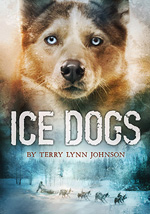 Still processing her beloved father's unexpected death, fourteen-year-old Victoria Secord loves nothing more than training her sled dog team in rural Alaska. She adores those dogs, especially Bean, the lead canine. Even though Victoria has great survival skills and knowledge of the wilderness, one of her mistakes may result in tragedy. When she heads off on a trip to buy more dogs from another musher who is planning to retire, she stumbles upon Chris, a teen injured in a snowmobile accident. Anxious about being around the sled dogs, Chris is new to the area and as inexperienced with the wilderness as someone can be. Still, the two fashion an uneasy partnership as they face hunger, exhaustion, and the cold as they try to survive nature’s challenges. Middle graders will enjoy this action-filled story, filled with you-are-there details about the great outdoors and the loyalty of furry friends. So effectively does the author describe the cold that readers will need to turn up their thermostats and throw their arms around their own canine companions for extra body warmth. The author keeps readers wondering about the fate of boy, girl, and dogs, almost to the very end.
Still processing her beloved father's unexpected death, fourteen-year-old Victoria Secord loves nothing more than training her sled dog team in rural Alaska. She adores those dogs, especially Bean, the lead canine. Even though Victoria has great survival skills and knowledge of the wilderness, one of her mistakes may result in tragedy. When she heads off on a trip to buy more dogs from another musher who is planning to retire, she stumbles upon Chris, a teen injured in a snowmobile accident. Anxious about being around the sled dogs, Chris is new to the area and as inexperienced with the wilderness as someone can be. Still, the two fashion an uneasy partnership as they face hunger, exhaustion, and the cold as they try to survive nature’s challenges. Middle graders will enjoy this action-filled story, filled with you-are-there details about the great outdoors and the loyalty of furry friends. So effectively does the author describe the cold that readers will need to turn up their thermostats and throw their arms around their own canine companions for extra body warmth. The author keeps readers wondering about the fate of boy, girl, and dogs, almost to the very end.
- Barbara A. Ward, Washington State University Pullman
Sovern, Megan Jean. (2014). The meaning of Maggie. San Francisco, CA: Chronicle Books.
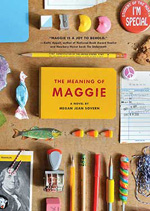 Birthdays are special occasions for Maggie Mayfield, newly turned eleven. Not only does the marking of one more year bring her closer to her life goals—college, running for president—but it also brings her that much closer to being treated as an adult and being let in on some of the family secrets to which her older sisters Tiffany and Layla are privy. But when she learns the truth about her father's ailments, she isn't quite so sure that she wants to grow up, after all. As she remains true to herself, she faces some pressure to change as the result of crush on a classmate, and she realizes that she may have misjudged others. Maggie is refreshing, quirky, and honest. She's dealing with quite a few issues, large and small, including body image issues, some of which are only touched on slightly.
Birthdays are special occasions for Maggie Mayfield, newly turned eleven. Not only does the marking of one more year bring her closer to her life goals—college, running for president—but it also brings her that much closer to being treated as an adult and being let in on some of the family secrets to which her older sisters Tiffany and Layla are privy. But when she learns the truth about her father's ailments, she isn't quite so sure that she wants to grow up, after all. As she remains true to herself, she faces some pressure to change as the result of crush on a classmate, and she realizes that she may have misjudged others. Maggie is refreshing, quirky, and honest. She's dealing with quite a few issues, large and small, including body image issues, some of which are only touched on slightly.
- Barbara A. Ward, Washington State University Pullman
Swinburne, Stephen R. (2014). Scientists in the Field: Sea turtle scientist. New York, NY: Houghton Mifflin Harcourt.
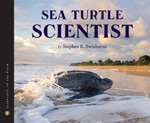 Filled with lively, engaging text and close-up photographs of some of the sea turtles that scientists are trying desperately to save, this book provides readers with a front-row seat to the laborious process the mother turtles endure in order to deposit their eggs. Heaving their cumbersome bodies across the sand in search of a safe place, the turtles use their flippers to dig a body cavity for the eggs, and then cover them with sand before heading back to the ocean where they can move more fluidly. Interestingly, very little is known about the male sea turtles. While the turtles are the reason for the book, the text focuses on the work of Dr. Kimberly Stewart who studies the turtles who nest on the beaches of St. Kitts. She counts the number of eggs laid by the mother turtles and even uses outreach work to gain the support of the local community for her important work in protecting turtles. Readers can't help being swept up by the enthusiasm of those who care about turtles and their hatchlings' perilous journey to the sea. This is another fine addition to the stellar series describing the field work of scientists.
Filled with lively, engaging text and close-up photographs of some of the sea turtles that scientists are trying desperately to save, this book provides readers with a front-row seat to the laborious process the mother turtles endure in order to deposit their eggs. Heaving their cumbersome bodies across the sand in search of a safe place, the turtles use their flippers to dig a body cavity for the eggs, and then cover them with sand before heading back to the ocean where they can move more fluidly. Interestingly, very little is known about the male sea turtles. While the turtles are the reason for the book, the text focuses on the work of Dr. Kimberly Stewart who studies the turtles who nest on the beaches of St. Kitts. She counts the number of eggs laid by the mother turtles and even uses outreach work to gain the support of the local community for her important work in protecting turtles. Readers can't help being swept up by the enthusiasm of those who care about turtles and their hatchlings' perilous journey to the sea. This is another fine addition to the stellar series describing the field work of scientists.
- Barbara A. Ward, Washington State University Pullman
Grades 9-12
Kephart, Beth. (2014). Going over. San Francisco, CA: Chronicle Books.
 Sixteen-year-old Ada lives on the west side of the Berlin Wall in 1983 before the wall separating the city is torn down. Her eighteen-year-old boyfriend Stefan lives on the east side and cannot cross over to see her. Since the wall and the area between both sides are patrolled by guards, the two spend much time yearning for each another. Stefan's dreams of a bright future are slowly being crushed by the mind-numbing physical labor of his daily life. He takes solace in looking at the stars through his grandfather's telescope. Ada, meanwhile, works with children during the day and creates graffiti paintings on the city's walls at night. When violence erupts in the life of one of the children, Ada insists that now is the time for Stefan to join her. Her need for him is palpable, if selfish. Stefan's own cunning in trying to find a way over the wall is admirable. Since the story is told from the different points of view of the two teens, readers are quickly thrust into their romantic predicament against a political backdrop while hoping for a positive resolution to the story. As is always the case with this author, all of the characters, even the secondary ones, are complex and have their own interesting stories. One aspect that may surprise readers is the large number of laborers from Turkey present in Berlin, a fact that seemingly leads to much misunderstanding, and ultimately, tragedy. Readers will finish the book and continue to think about how effective one wall can be in separating a country and in fashioning attitudes toward life.
Sixteen-year-old Ada lives on the west side of the Berlin Wall in 1983 before the wall separating the city is torn down. Her eighteen-year-old boyfriend Stefan lives on the east side and cannot cross over to see her. Since the wall and the area between both sides are patrolled by guards, the two spend much time yearning for each another. Stefan's dreams of a bright future are slowly being crushed by the mind-numbing physical labor of his daily life. He takes solace in looking at the stars through his grandfather's telescope. Ada, meanwhile, works with children during the day and creates graffiti paintings on the city's walls at night. When violence erupts in the life of one of the children, Ada insists that now is the time for Stefan to join her. Her need for him is palpable, if selfish. Stefan's own cunning in trying to find a way over the wall is admirable. Since the story is told from the different points of view of the two teens, readers are quickly thrust into their romantic predicament against a political backdrop while hoping for a positive resolution to the story. As is always the case with this author, all of the characters, even the secondary ones, are complex and have their own interesting stories. One aspect that may surprise readers is the large number of laborers from Turkey present in Berlin, a fact that seemingly leads to much misunderstanding, and ultimately, tragedy. Readers will finish the book and continue to think about how effective one wall can be in separating a country and in fashioning attitudes toward life.
- Barbara A. Ward, Washington State University Pullman
MacColl, Michaela. (2014). Always Emily. San Francisco, CA: Chronicle Books.
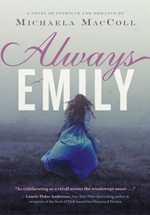 Fans of this author love how she deftly creates books based on real-life characters, perhaps heroines in their own rights. In this case she tackles the Bronte sisters, fleshing out the characters so remarkably that they simply spring to life on her pages. Fans of the Brontes' work, still popular today, will find hints of the stories they end up writing in the events of the sisters' own days spent living in their father's parsonage on the moors. Although they are related by blood, the sisters couldn't be different. Charlotte, the older sister, is careful and takes few risks while Emily is daring and impulsive. Although they share a love for writing, it's safe to say that they don't understand one another. As the siblings work to solve several mysteries about several local burglaries against the backdrop of their brother's strange behavior, the rudeness of a local landowner, a mysterious young man Emily meets, and a chance encounter with a woman desperate to escape her circumstances will all take on much significance over the course of time. This peek into the formative years and daily existence of Charlotte and Emily provides insight into the girls who would become authors.
Fans of this author love how she deftly creates books based on real-life characters, perhaps heroines in their own rights. In this case she tackles the Bronte sisters, fleshing out the characters so remarkably that they simply spring to life on her pages. Fans of the Brontes' work, still popular today, will find hints of the stories they end up writing in the events of the sisters' own days spent living in their father's parsonage on the moors. Although they are related by blood, the sisters couldn't be different. Charlotte, the older sister, is careful and takes few risks while Emily is daring and impulsive. Although they share a love for writing, it's safe to say that they don't understand one another. As the siblings work to solve several mysteries about several local burglaries against the backdrop of their brother's strange behavior, the rudeness of a local landowner, a mysterious young man Emily meets, and a chance encounter with a woman desperate to escape her circumstances will all take on much significance over the course of time. This peek into the formative years and daily existence of Charlotte and Emily provides insight into the girls who would become authors.
- Barbara A. Ward, Washington State University Pullman
Reed, MK, & Means, Greg. (2013). The Cute Girl Network. Illus. by Joe Flood. New York: First Second.
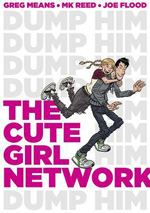 When Jane moves to Brookport, she's eager to soak up the flavors and experiences of her new home. She and Jack meet in adorable fashion near the soup truck where he works. The attraction is mutual, and they begin to spend as much time as possible with each other. A skateboarder, Jane encounters sexist attitudes at work and when she's on her board. Jack is not exactly filled with lofty ambitions and has had more than one unsuccessful relationship. When it turns out that he once dated one of Jane’s new roommates, another roomie suggests that she check out the opinions of the local Cute Girl Network, a group of women who spill all the dirt about their former lovers. Despite the negative information she learns about Jack, Jane is convinced that she is strong enough to deal with whatever comes her way, and that she likes Jack, flaws and all. After all, she has plenty of skeletons in her own relationship closet as well. Not only is the story itself delightful, but the artwork contains all sorts of hidden treasures such as the message on the needlework being completed by Rose, one of Jack's roommates.
When Jane moves to Brookport, she's eager to soak up the flavors and experiences of her new home. She and Jack meet in adorable fashion near the soup truck where he works. The attraction is mutual, and they begin to spend as much time as possible with each other. A skateboarder, Jane encounters sexist attitudes at work and when she's on her board. Jack is not exactly filled with lofty ambitions and has had more than one unsuccessful relationship. When it turns out that he once dated one of Jane’s new roommates, another roomie suggests that she check out the opinions of the local Cute Girl Network, a group of women who spill all the dirt about their former lovers. Despite the negative information she learns about Jack, Jane is convinced that she is strong enough to deal with whatever comes her way, and that she likes Jack, flaws and all. After all, she has plenty of skeletons in her own relationship closet as well. Not only is the story itself delightful, but the artwork contains all sorts of hidden treasures such as the message on the needlework being completed by Rose, one of Jack's roommates.
- Barbara A. Ward, Washington State University Pullman
These reviews are submitted by members of the International Reading Association's Children's Literature and Reading Special Interest Group (CL/R SIG) and are published weekly on Reading Today Online.
The CL/R SIG is accepting submissions to the fall 2014 edition of their journal, The Dragon Lode, through April 15, 2014. There is an open theme, and they invite manuscripts that explore contemporary issues and questions, genre study, literary theory, and research related to children's literature and reading. Manuscripts should be no longer than 20 double-spaced, typed pages. Use APA (6th edition) formatting. Author's name, affiliation, mailing address, telephone and fax numbers, and e-mail address should be on a separate cover page. Photos and illustrations should be sent as a separate jpeg file. Any reference to the author that would enable the reviewer to know the author's identity should not appear in the manuscript. Submit all manuscripts to: Dr. Ruth McKoy Lowery, Co-editor.